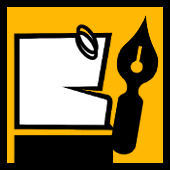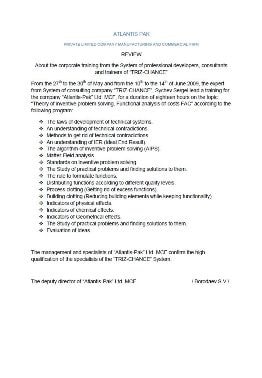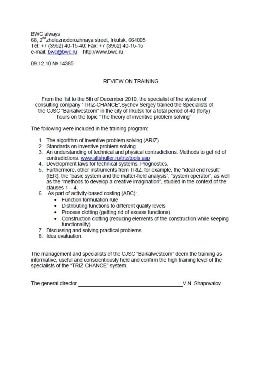Business process with TRIZ help
TRIZ in the problem solving processTRIZ – Theory of inventive problem solving – is the strongest to date system for creating new ideas and inventions. It is widely known and used in many countries: In USA, UK, Germany, Sweden, France, Japan, Spain, Canada etc.
Most of leading companies are actively using that methodology for improving their goods and services. Among those companies are Samsung Electronics, Intel, LG Electronics Inc., Lucent Technologies, Xerox, Boeing, Siemens etc.
With the help of TRIZ You can learn how: to create the inventions, to solve the tasks so complicated that they are considered intractable by the other people, to eliminate technical contradictions, to predict the development of the technologies.
TRIZ programs
VARIANT 1
TRIZ. Business innovations
- What is TRIZ? Differences from other means to find new ideas. Brief history of TRIZ.
Laws of development of technological systems and predictions on new technologies. Key applications of TRIZ to a business. Problem solving.
- Basic concepts. "Inventive situation" and "inventive problem". Maxi-problem. Mini-problem. The concept of the "ideal
system". IER (ideal end result). The law of increasing the degree of ideality. Problem solving.
- The concept of technical contradictions. The law of uneven development of technical systems. The first part of
ARIZ (Algorithm of Inventive Problem Solving). Problem solving.
- The laws of transition to the super-system and to the micro level. The concepts of "operational zone" and
"operative time". The concept of the "resource". Forecasting the development of commercial projects.
- The concept of "physical contradiction." Methods to eliminate physical contradictions. The second and third part
of the algorithm of Inventive problem solving ARIZ-85B. Problem solving.
- The concept of the "elementary technical system" (Su-field). Su-Field analysis. Standards for inventive problem solving.
1st class. Standards for inventive problem solving. 2nd class. Problem solving.
- Fourth part of ARIZ-85В. MLP method. Standards for inventive problem solving 3rd class. Problem solving.
- Standards for inventive problem solving 4th class. Fifth and sixth parts of ARIZ-85В. Signs of physical, chemical
and geometrical effects. Problem solving.
- Standards on inventive problem solving. 5th class. Conclusive (7-9) parts of ARIZ-85В. Problem solving.
- Fragments of the course "Development of creative imagination DCI". Problem solving. Training attendents to develop their own project.
VARIANT 2
TRIZ. The optimization of business processes
Nowadays, business must become innovative. Today, all businesses have the compulsive need to increase efficiency while reducing costs and effort.
If a large company can afford the high cost of certain projects, the small entrepreneur (especially at the start) is forced to rely on his own knowledge, creativity and entrepreneurship. No idea - no business.
Therefore, in order to attain success on the market, the entrepreneur has to get the technology to create new solutions, including the technology to create inventions and obtain the appropriate knowledge and skills for inventive problem solving.
That is why TRIZ is actively and widely used to optimize business processes. The knowledge and application of TRIZ provides a strong competitive advantage for any company.
I. The rules for structuring business processes
- Myths and prejudices about business processes, their description, optimization, etc. Typical mistakes in designing business processes.
- Improving results while reducing effort is the only purpose of business structuring. The rules of business structuring.
- The ideal job is one providing results without actual work. The rules to form functions.
- Methods to detect large areas with unproductive expenses rapidly. Eliminating unproductive costs from our business with the help of TRIZ.
- Problem solving.
II. Optimization methods. Level 1
- "Diversifying" work according to different quality levels.
- "Expense curtailing of the 1st type". We make sure that less people perform the same task with less effort.
- We determine the optimal number of posts.
- We determine the actual workload of staff.
- Problem solving.
III. Optimization methods. Level 2
- "Expense curtailing of the 2nd type". Make sure that work is reduced, while results are still obtained and improved. 6 (six) key methods to curtail work without affecting the result.
- About "Expense curtailing of the 3rd type'. We question the need for some of the results of the current business process. Reduce costs after changing the results.
- Problem solving.
VARIANT 3
TRIZ. Evolution of services
- Introduction. Aims and methods of the seminar
- What is "curtailing of business-processes". Why is the "curtailing of business-processes" conducted. Which results can be achieved. "Curtailing of business-processes" and TRIZ.
- Basic terms, tools and an overview of the entire course. The concept of the "ideal process".
- Analysis of examples.
- The rules to structure business processes.
- Improving result while reducing effort is the only purpose of business structuring.
- Typical mistakes in designing process structures (at the level of the department, post and company in general).
- The main rules for process structuring and methods to detect large areas of unproductive expenses rapidly.
- Methods of business structuring, when results improve with lower expenses.
- Business processes of different companies, "how they actually look like" - a resource on ideas for new services.
- Analysis of examples.
- About the levels of curtailing of business-processes.
- The concept of different quality levels of curtailing.
- Three quality levels of curtailing. Overview.
- Analysis of examples.
- First level of curtailing: "Performing a large amount of work with less effort, a fewer number of participants and low qualification requirements for them".
- Rules describing the processes for curtaling purposes.
- Diversifying works within a process for different quality groups.
- Performing level 1 curtailing.
- Consider it as a resource for new services.
- Analysis of examples and problem solving.
- Second level of curtailing: "Eliminating jobs while increasing results" .
- The "Ideal job" - is one providing results without actual work.
- "Useless work" – is one which is performed without any result and is superfluous.
- 7 (seven) lethal management "sins", easily paralyzing any business process, irrespective of the fact whether it was "optimized or automated".
- Standards to ban these 7 "sins", as part of corporate culture. Preliminary ("hygienic") procedures before curtailing.
- 6 (six) key methods to eliminate "large amounts of work" without affecting results.
- A few methods to eliminate "large amounts of small works", as well as "pulling", "switching" etc.
- Analysis of examples and problem solving
- Third level of curtailing: "Do we actually need these results?» Reducing and changing purposes. Eliminating whole processes".
- The results of the process are exterior. The value of the results does not change as per the company but rather the market.
- We cross the limits of the process. Transition to the super-system. The law of transition to the super-system and our business processes.
- Other people's business processes. How to study them in order to provide them with services?
- Entrepreneurial solutions. Differences between entrepreneurial solutions and inventive ones.
- Analysis of examples and problem solving.
- Forecasting. Laws of service development.
- About forecasting methods.
- Classical TRIZ patterns used to predict services: "increasing ideality", "transition to the super-system", "S-curve", "uneven development" and others.
- New materials, not described in TRIZ-literature:
- "Development patterns of commercial services",
- "The life cycle of commercial topics in media",
- "How to predict switches in trends from rental to purchase and back".
- Analysis of examples and problem solving.
- Workshop on forecasting the development of services, in which employees participate now. (Services 1)
- Building a model for future development "Services 1".
- Forecasting "Services 2", which at a certain moment will push "Services 1" off the market.
- Prediction of inventions and changes in the market, which eliminate the very need for "Services 1 and 2" and analogues. Is it possible to create such solutions on our own?
- Workshop on "Working with stereotypes of Customer service".
- Methods of collecting potential customer stereotypes.
- Methods to correct negative stereotypes.
- Methods to overcome indifference.
- Methods to boost positive stereotypes of Clients.
- Workshop Summary. Answers to the questions.
The form of studing
For whom:
Corporate event with the possible participation of entrepreneurs, business owners, top managers, engineers (designers, technologists, programmers, etc).
The form of studing:
The workshop with the solving of practical-tasks of the Participants.
The place it can take:
- in any country and town;
- via Internet – webinars.
The duration:
- 24 hours;
- 40 hours.
On what language the studies are held:
The studies are conducted on any language (with the assistance of an interpreter).

















